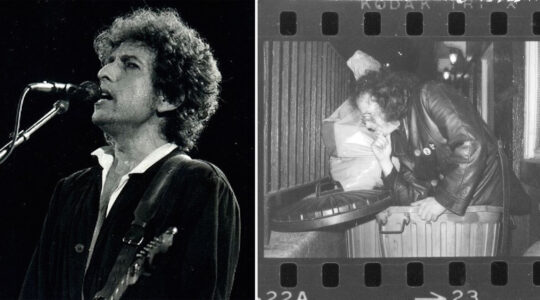If Andrew Lloyd Webber supersized the Broadway musical, inflating it with an operatic grandeur that distanced it from everyday life, Stephen Sondheim made it about us — our relationships, our struggles for self-esteem, our wrestlings with our yearnings and fears.
How fitting then, that Broadway should mount a show about the man who has held up a mirror to us. In “Sondheim on Sondheim,” directed by James Lapine, which opened last Thursday at the Roundabout Theatre’s Studio 54, taped interviews with the great American composer provide a backdrop to live performances by a cast of eight Broadway veterans — Barbara Cook, Vanessa Williams, Tom Wopat, Leslie Kritzer, Norm Lewis, Euan Morton, Erin Mackey, and Matthew Scott — of songs from every one of his shows. While much of the show seems somewhat slapdash, and many of the songs are not the composer’s best, there are enough heart-stopping performances of particular numbers to make the show well worth seeing.
But despite the production’s title and conceit, do we really learn much about the composer himself?
The show’s most indispensable presence is that of the 82-year-old Cook, who has been one of Sondheim’s most dependable and moving interpreters for the last 25 years; her renditions of “Not a Day Goes By,” “In Buddy’s Eyes,” and “Send in the Clowns” are nothing short of spectacular. Williams is also stunning, both physically and vocally; her striptease in “Ah, But Underneath” from the London revival of “Follies” is a high point of the show.
The rest of the cast is less memorable, although Norm Lewis acquits himself beautifully in “Being Alive” from “Company” and Leslie Kritzer has pitch-perfect voice and comic timing in “Now You Know” from “Merrily We Roll Along.” Euan Morton and Tom Wopat seem less in their element; Morton could be better used than he is in the overlong and not very funny number, “Franklin Shepard, Inc.” from “Merrily,” and Wopat is an unconvincing Sweeney Todd in “Epiphany” although he nails the ballad “Finishing the Hat,” from “Sunday in the Park With George.” The emotional texture of each of Sondheim’s shows is so specific that it often does not work to wrench a song out of context; this is a complaint that critics have made about other anthology shows of Sondheim, “Putting it Together” and “Side by Side by Sondheim.”
Beyond the actual music, what makes the show extraordinary is the jaw-dropping use of video screens for the interviews, dozens of rectangular screens that first make up a single larger screen but then jig-saw off in different patterns, finally ending up splayed on a heap on a low circular staircase, pointing in different directions. These screens can show parts of the same image, or show different images, or all show the same image—and they can also display computer animation.
Sondheim is thus shown from a multiplicity of angles and perspectives, mostly as he is lying on his couch or sitting at his piano, while he is talking about his life, the story behind his compositions, or his creative process in general. The interviews are often so interesting — and shown in such a cutting-edge technological way — that sometimes the songs feel like an unwelcome interruption of the story being told through the interviews.
Most interesting are the moments when the interviews and the performers are in tension with one another; at one point, Sondheim, who the performers have been venerating as “God,” presents himself as so insufferably egotistical that one of the singers grabs a remote and turns him off.
But how much do we learn about Sondheim himself? The composer does talk openly in the interviews about his terribly unhappy childhood — his parents divorced when he was 10 years old — and his finding Oscar Hammerstein as a surrogate father. He refers obliquely to his homosexuality and he even recalls the heart-breaking moment when his mother told him that she wished that she had never given birth to him. But none of this is truly new; a search on Wikipedia contains all this information and more.
What the show never mentions, for those of us on the lookout for it, is Sondheim’s Jewish background — or whether he still considers himself to be Jewish at all. There is certainly nothing new about American Jewish composers and other artists being assimilated; in fact, they were so secular that they secularized the whole country, including its Christian majority. As Philip Roth famously said of Irving Berlin, only a Jew could have taken Christmas out of “White Christmas” and taken Easter out of “Easter Parade,” making one a holiday about snow and the other a holiday about a clothing pageant. Indeed, Sondheim has almost no overt Jewish content in any of his work; one would have to argue for a Jewish sensibility somehow inherent in his use of conflicted, neurotic characters or in the ways that his music, deriving from a place of marginalization, provides a discordant antidote to mainstream American theater music. Connecting this to Jewishness would be quite a stretch.
Why do we need to claim him as Jewish? Is it intolerable for us that many of our nation’s geniuses want little to do with Judaism or the Jewish people? In Sondheim’s case, as “Sondheim on Sondheim” makes abundantly clear, it is his collaborators in theater that have become both family and community to him. His sense of outsiderness, which he has expressed in interviews, seems to stem mostly from his homosexuality rather than any kind of religious or ethnic identity.
In the end, the riddle of Sondheim’s Jewishness is the riddle that many Jews face, whether consciously or not. Does our creative energy stem in any way from our Jewish identity, whether or not that creativity is channeled in a Jewish direction? Does simply being born Jewish make us Jewish in any meaningful way? And why do we need others, especially the most distinguished members of our society, to sign on to a kind of membership in the Jewish community for which they may have little use?
These are questions that, as the title of “Sondheim on Sondheim” suggests, go on and on. Sondheim, after all, is a master of unanswered questions and unresolved dilemmas.
Aren’t we still waiting for the clowns?
“Sondheim on Sondheim” runs through June 13 at Studio 54, 254 W. 54th St. Performances are Tuesday-Saturday at 8 p.m., with matinees on Wednesday, Saturday and Sunday at 2 p.m. For tickets, $36.50 to 126.50, call Roundabout at (212) 719-1300 or visit www.roundabouttheatre.org.
|
Signup for our weekly email newsletter here. Check out the Jewish Week’s Facebook page and become a fan! And follow the Jewish Week on Twitter: start here. |
The New York Jewish Week brings you the stories behind the headlines, keeping you connected to Jewish life in New York. Help sustain the reporting you trust by donating today.




